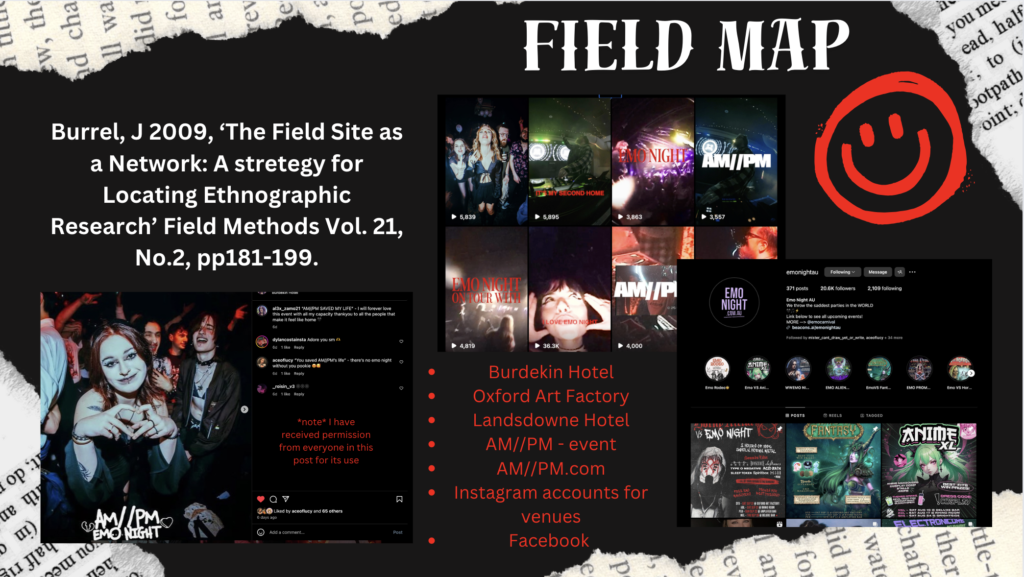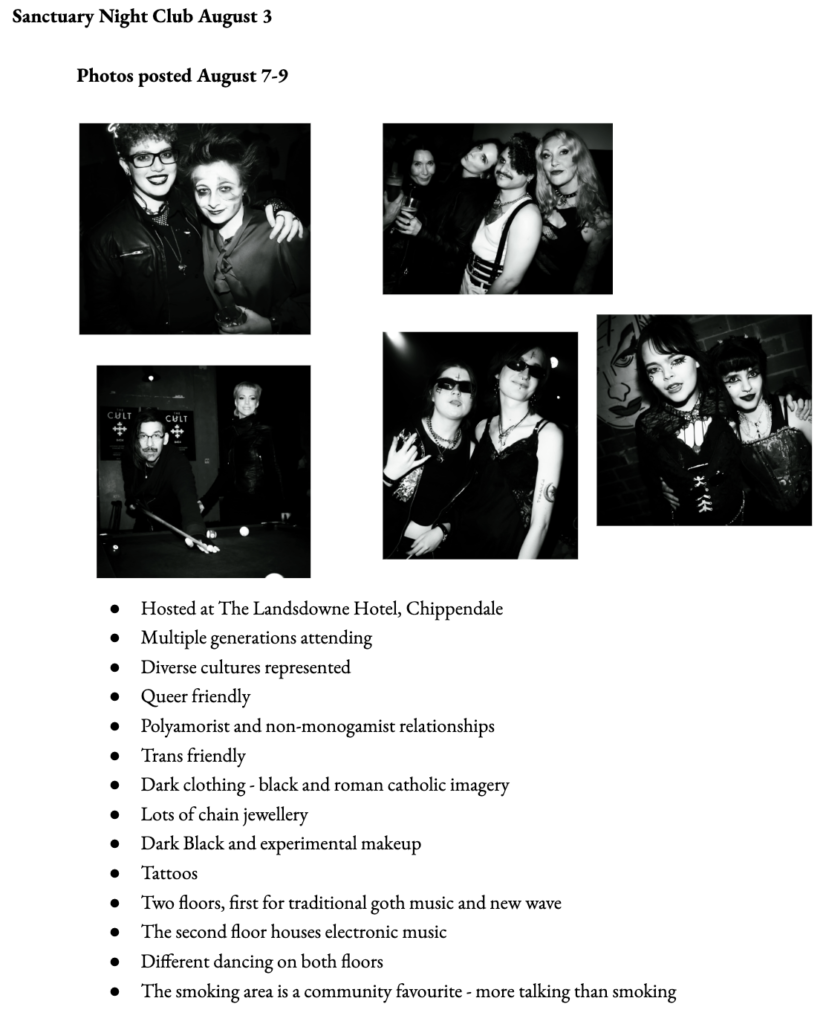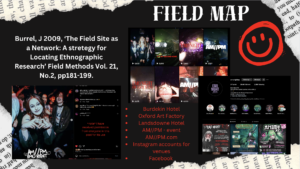Auto-ethnographic Exploration of Emo Nights
AM//PM is an alternative nightclub that offers a unique space for local bands to perform and for fans to enjoy emo, pop punk, and party tunes in a safe, inclusive environment. This venue serves as a haven for those immersed in alternative music culture, fostering a community where like-minded individuals can connect. Drawing on ethnographic literature, my research explores how AM//PM at The Burdekin Hotel, alongside its close affiliation with the nearby Oxford Art Factory, creates a shared space for alternative music enthusiasts.

As a queer, autistic, trans-masculine nonbinary individual, my experiences have profoundly shaped my understanding of the world, particularly in the context of alternative music spaces like Emo Nights. The repetitive nature of the music, scene, and venue provides comfort and familiarity, allowing me to immerse myself fully. Despite gendered bathroom labels, I and a myriad of attendees use these spaces as gender-neutral, reflecting a desire for inclusivity and safety.
My affinity for punk rock and emo music, shared by many AuDHD attendees, is tied to the physical and emotional release I find in loud music and endless dancing. Hyper empathy and a strong sense of justice drive my engagement in this field, offering the dopamine boost I seek in such environments. As someone who enjoys alternative makeup styles and rejects rigid gender norms, the nightclub space provides a rare opportunity to express myself freely, without judgment. These experiences inform my view of such spaces as vital sanctuaries for those who, like me, find solace in the alternative.
At Sanctuary, each floor had its pulse – upstairs was alive with the electronic beat, while downstairs, the deeper, more melodic tones of goth and new wave music filled the air. I noticed the dance styles on each floor, revealing subtle differences in how people engaged with the music. But the smoking area, despite its name, became more of a hub for conversation than smoking-where the real sense of community seemed to come alive, far more than on the dance floors: Burdekin, similarly, has multiple floors, each with a different feel and presence.

In a moment of realisation, I became acutely aware that this was not just another night out—it was a living, breathing expression of community. The nightclub was a convergence of multiple generations, cultures, and identities, all coexisting in one space. Queer and trans individuals felt a profound sense of belonging, while polyamorous and non-monogamous relationships were embraced without hesitation. The aesthetic—dark clothing rich with Roman Catholic imagery, chains, tattoos, and experimental black makeup—was not just a fashion statement but a shared identity that symbolised participation in an alternative scene. This epiphany aligns with Davis’ (2008) exploration of how nightclubs serve as spaces for identity performance, particularly for marginalised groups who use such environments to express and negotiate their identities free from societal constraints. Likewise, Buckland (2002) points out in her work on queer club culture that nightclubs function as spaces where normative boundaries are suspended and alternative forms of belonging are embraced.
One pivotal epiphany from my experience at Emo Nights occurred when I observed how wheelchair users at Burdekin are often confined to the ground floor. While they have access to live music and a bar, the bathrooms are inaccessible, and their view of the stage needs to be improved. This often requires them to rely on a friend or carer for basic needs like moving around or ordering a drink. Tutenges (2022) emphasises the importance of understanding how individuals navigate nightlife spaces and the barriers that exist. In line with his phenomenological approach, this epiphany brings attention to how physical limitations in a nightclub can impact the lived experience of individuals with disabilities. Despite the club’s efforts to foster an inclusive culture for various marginalised identities, its physical layout inadvertently reinforces ableism, highlighting how inclusive intent can fall short in practice. This mirrors broader societal challenges where physical spaces, though meant to be shared, often remain inaccessible to disabled individuals, further marginalising them. Similarly, Davis (2008) notes the structure of a nightclub can transform or restrict social space, influencing who can participate fully in the experience. This epiphany underscores the need for more comprehensive accessibility measures to ensure that all individuals can engage in and enjoy these cultural spaces regardless of ability.
My autoethnographic research reveals how nightlife spaces like Emo Nights serve as cultural hubs and sites of social exclusion. The contrast between communal bonding in unexpected areas like the smoking section and the exclusion of wheelchair users due to poor accessibility highlights the complexity of these environments. These insights underscore the need for greater inclusivity in nightlife spaces to ensure everyone can fully participate in subcultural communities.
Ampmemonight, 2024, Screen Team, AM//PM, Instagram, viewed 20 August 2024,<https://www.instagram.com/p/C7Bbk8xS88P/?hl=en>.
Buckland, F 2002, ‘Impossible Dance: Club Culture and Queer World-Making’ Wesleyan University Press.
Davis, A 2008, ‘Dragging Identity: A Critical Ethnography of Nightclub Space(s)’, Media and Communication Ph.D. Dissertations.
Tutenges, S 2022, ‘Nightlife Ethnography: A Phenomenological Approach’, In S. M Bucerius, K. Haggerty& Berardi (Eds.), The Oxford Handbook of Ethnographies of Crime and Criminal Justice (pp. 408-426). Oxford University Press.
